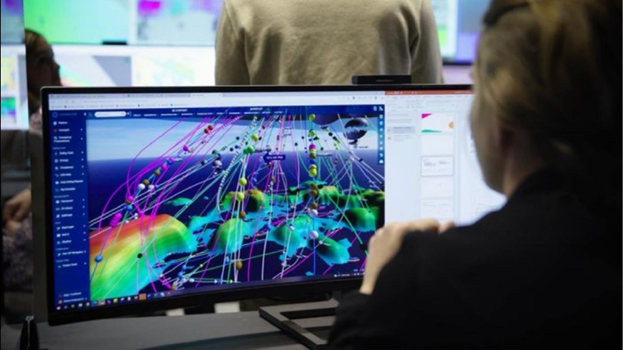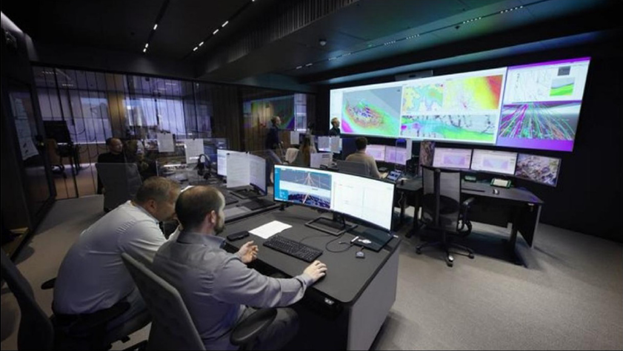Aker BP and Halliburton first joined forces in 2017 to automate and optimize well planning and design to accelerate delivery and reduce costs. Four years later, the alliance successfully innovated a well design system which reduces planning time.

The Digital Well Program®, a DecisionSpace® 365 solution has reduced the time it takes to design a well from 30 days to closer to one. Halliburton and Aker BP further extended this project to develop a solution to automate the entire field development. Photo: Woldcam / Aker BP
At the heart of that collaboration was Digital Well Program®, a DecisionSpace® 365 solution, which enabled engineers to minimize well design time from 30 days to close to 1 day.
Now the two companies have joined forces to develop Field Development Planning, a DecisionSpace® 365 solution to optimize the development of entire oil and gas fields. By automating the entire process, Halliburton and Aker BP aim to save time, optimize engineering efficiency and increase the quality of field development.
Halliburton’s solution can aggregate data from multiple sources and offer accurate proposals for the ideal development plan for a specific field based on, among other things, economics, technical capabilities and CO2 emissions.
Solving Fundamental E&P Challenges
The Field Development Planning solution is a logical extension of the well planning optimization project and can help to rapidly analyze the subsurface and all facilities associated with a field. This will empower E&P companies to reduce costs, uncertainty and risk for the project, as well as minimize emissions.
This new initiative aims to solve a key problem faced by the oil industry – the considerable time gap between the discovery of a field and the start of production.
“A field will go through several phases of maturation and development, and for most operators this takes many years, and for some fields, it might be as long as a decade”, points out Nagaraj Srinivasan, Senior Vice President of Landmark, Halliburton Digital Solutions and Consulting.
In addition, these decisions are made based on technical, operational, and financial analysis, and involve finding a balance between these. It requires close collaboration across multiple departments and levels in a company, all of which have their own data, geologists, reservoir engineers, economists etc. Today, the field development process is quite manual.
“For every milestone in a project, new meetings will need to be coordinated and new data needs to be analyzed. Imagine the number of documents that are produced and shared manually throughout the decision-making process”, says Chandra Yeleshwarapu, Senior Director, Products, Customer Experience, and Business Development, Halliburton.
The Shift from Manual to Automation
The data that already exists in all different silos needs to be brought together, so you get a smoother and faster process. The solution collects the data and makes it available to everyone at any time across departments; this makes it much easier to coordinate the decision-making process.
The Field Development Planning software will generate several scenarios or concepts for developing a field and analyzes different trade-offs that exist between the variables. It can range from economics, risk, CO2 emissions etc. and the software will also make recommendations for selecting the optimal concept.
These accurate field insights can provide a clear understanding of uncertainty and risk in the early phase level of development.
Enabling Data-driven Decisions
For Aker BP, the Field Development Planning software will unlock completely new opportunities to make data-driven decisions for the entire field concept. It will provide a comprehensive picture of field development and well construction, which will empower the company to make faster and better subsurface, reservoir and production decisions. The goal here is to ensure optimal investments and the highest possible return on the company's assets.
“We achieve this by analyzing complex scenarios for each project at a much faster rate. We also get better data, early in the field development process”, says Arnfinn Grøtte, Drilling & Wells Manager Digitalization, Aker BP.
Aker BP believes this solution will revolutionize the way the company works in field development. The system takes care of the more trivial tasks so that the engineers can work on what is most important. This allows them to focus more on creativity, creation and quality and facilitates better decisions.

Halliburton and Aker BP hope to have results from the collaboration on a field development software ready in the coming months. Photo: Woldcam / Aker BP
"The discoveries we develop will be smaller and the wells more complex. We want to automate all the basic tasks, so that we can focus more on the challenges and risks of the project. This means that we can use the engineering learning in a much better way to optimize the development concepts", explains Arnfinn Grøtte.
The two companies have already cut the time it takes to plan a well from months to weeks and are now approaching one day, and they expect to replicate similar optimization levels for field planning.
"Not only will the costs be lower, but you can start generating income earlier, which is the most exciting part of our industry", according to Nagaraj Srinivasan.
Flexible Deployment: New and Mature Fields
The Field Development Planning solution is designed not just for the development of new fields. Aker BP will also use it for further development of mature fields and finding solutions for connecting fields to existing infrastructure. "It will address the entire portfolio", says Arnfinn Grøtte.
For an existing field, you have the advantage of having more reservoir data, more wells drilled, more production data and a deeper understanding of the subsurface. At the same time, there are greater restrictions around newly deployable solutions. For new fields, you have no production data from existing wells, and there will be greater uncertainty, but you have far greater freedom in terms of designing and deploying new solutions. A user will be able to concentrate on different factors while using the Field Development Planning environment, but otherwise the two approaches will be the same, it works the same way, says Nagaraj Srinivasan.
The Halliburton - Aker BP Alliance
The Halliburton – Aker BP Alliance is not a traditional customer/supplier relationship, the two companies collaborate and co-innovate to find the most optimal solution for solving key E&P challenges. The partnership follows a simple and effective working model: Aker BP presents the challenges they encounter, and the Halliburton team develops the software and solutions to solve the problem.
Halliburton and Aker BP have now been working on the Field Development Planning project for the past year and they expect to roll out the first phase of the project within a few months. To start off, Aker BP will implement the software on one of its assets with an ongoing field development project. The plan is to eventually use it in all fields. The goal is for the oil company to be a fully digital and fully automated company by the end of this decade.
The rapid investment in digitalization aligns well with Aker BP’s growth plans in the coming years. Following the merger with Lundin in June 2022, Aker BP will be the next largest operator on the Norwegian shelf and will operate six field centers. In addition, the company has plans to submit development plans for several major projects during this year, including NOAKA, Valhall PWP-Fenris and Skarv satellite project.
In total, Aker BP plans to invest NOK 150 billion in the Norwegian shelf over the next five to six years, and they aim to grow daily production from approximately 400,000 barrels to well over 500,000 barrels per day in a few years.
“For Aker BP to succeed in becoming an oil and gas company of the future, we will have to develop more efficient ways of finding, developing, and producing oil and gas. We believe that only the companies that produce oil and gas with the lowest costs and the lowest emissions will survive. Aker BP will be the first truly data-driven oil and gas company in the world. This means that we collect and track all data used in each decision point throughout our field development processes, and based on the available interpretation of our data, drive the next step in our work process. This unlocks efficiencies, speed and quality that were not previously achievable”, says Chief Digital Officer Paula Doyle, Aker BP.
KeyFacts Energy Industry Directory: Aker BP Norway country profile l KeyFacts Energy Industry Directory: Halliburton
 KEYFACT Energy
KEYFACT Energy